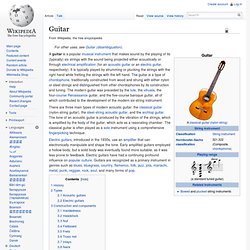

I Heart Guitar. WholeNote - The On-Line Guitar Community - with guitar lessons OLGA guitar tab music chords scales and other goodies... Learning the Parts of the Guitar (diagram) - Beginner Guitar Lessons. Headstock The headstock is the head of the guitar. Headstocks come in different shapes and contain the tuning pegs. Some headstocks have three tuners on both sides, others have all the tuners on one side Tuners There is one tuner for every string on the guitar. Nut The nut is located at the top of the neck, it has grooves to hold each string in the right location. Fingerboard The fingerboard or fretboard is made of wood, usually maple or rosewood. Frets The frets are metal inserts that mark the different pitches on the fretboard. Guitar Strap Button The guitar strap button is to connect your guitar strap to your guitar Pick Guard The pick guard is located under the pick-ups and protects the guitar from pick scratches.
Pick-ups Pick-ups are magnets that pick up vibrations from the strings. Pick-up Toggle Switch This is a selector switch, that switches between pick-ups or uses both at the same time. Volume and Tone Control These dials control the signal volume from each pick-up. Bridge. Joe Satriani - Always with me, always with you. Life Lessons From The Fretboard. Welcome to Sweetwater.com. Guitar. History Before the development of the electric guitar and the use of synthetic materials, a guitar was defined as being an instrument having "a long, fretted neck, flat wooden soundboard, ribs, and a flat back, most often with incurved sides".[1] The term is used to refer to a number of chordophones that were developed and used across Europe, beginning in the 12th century and, later, in the Americas.[2] A 3,300-year-old stone carving of a Hittite bard playing a stringed instrument is the oldest iconographic representation of a chordophone.[3] The term guitar is descended from the Latin word cithara but the modern guitar itself is generally not believed to have descended from the Roman instrument.

Many influences are cited as antecedents to the modern guitar. A guitarra latina (left) and a guitarra morisca (right), Spain, 13th century Types Guitars can be divided into two broad categories, acoustic and electric: Acoustic guitars Renaissance and Baroque guitars Classical guitars Flamenco guitars. Guitar Chord Charts - Beginner Guitar Lessons. Technically speaking, a guitar chord is three or more notes played in unison. Although "power chords" (dyads) are usually referred to as chords. A chord is named by its root note and the intervals between the following notes. For more on this click here. How To Read a Guitar Chord Chart The guitar chord charts represent a guitar fretboard, with the vertical lines being the guitar strings and the horizontal ones being the frets. Acoustic Guitar Chords and Electric Guitar Chords? Many beginners have asked if there a difference between the chords played on an acoustic guitar and an electric guitar.
Jazz Guitar Chords Seventh chords and their extensions, 9ths, 11ths, and 13ths are sometimes referred to as Jazz chords, as that is where they are primarily used. Chord Voicings The notes of a chord can be arranged in many different ways. Chord inversions In an inverted chord, the root note is not in the bass. C Major Chord Inversions The more notes a chord has the more inversions it can have. Beginner Guitar Lessons - Guitar tips, tricks, music theory.